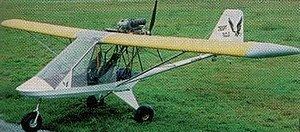Manufacturer Olympic Ultralights | ||
 | ||
The Olympic Desert Eagle was an American homebuilt aircraft that was designed and produced by Olympic Ultralights of Port Angeles, Washington. When it was available the aircraft was supplied as a kit for amateur construction.
Contents
Design and development
The Desert Eagle featured a strut-braced high-wing, a two-seats-in-side-by-side configuration semi-enclosed cockpit, fixed tricycle landing gear without wheel pants and a single engine in pusher configuration.
The aircraft was made from bolted-together aluminum tubing, with its flying surfaces covered in Dacron sailcloth. Its 33.00 ft (10.1 m) span wing which mounted flaps, had an area of 165.0 sq ft (15.33 m2) and was supported by "V" struts and jury struts. The cabin width was 50 in (130 cm). The acceptable power range was 65 to 90 hp (48 to 67 kW) and the standard engine used was a 80 hp (60 kW) Motavia powerplant.
The Desert Eagle had a typical empty weight of 495 lb (225 kg) and a gross weight of 1,200 lb (540 kg), giving a useful load of 705 lb (320 kg). With standard full fuel of 10 U.S. gallons (38 L; 8.3 imp gal) the payload for the pilot, passenger and baggage was 645 lb (293 kg).
The standard day, sea level, no-wind takeoff run with a 80 hp (60 kW) engine was 200 ft (61 m) and the landing roll was 150 ft (46 m).
Factory options included optional fuel tanks of 20 U.S. gallons (76 L; 17 imp gal) and 55 U.S. gallons (210 L; 46 imp gal) capacity. The manufacturer estimated the construction time from the supplied kit to be 240 hours.
Operational history
In February 2015 no examples were currently registered in the United States with the Federal Aviation Administration, as the sole one's registration had expired on 30 September 2013.
Variants
Specifications (Desert Eagle)
Data from AeroCrafter
General characteristics
Performance
